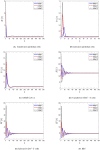Stability analysis of within-host SARS-CoV-2/HIV coinfection model
- PMID: 35942149
- PMCID: PMC9348514
- DOI: 10.1002/mma.8457
Stability analysis of within-host SARS-CoV-2/HIV coinfection model
Abstract
The world has been suffering from the coronavirus disease 2019 (COVID-19) since late 2019. COVID-19 is caused by a virus called the severe acute respiratory syndrome coronavirus 2 (SARS-CoV-2). The human immunodeficiency virus (HIV) coinfection with SARS-CoV-2 has been reported in many patients around the world. This has raised the alarm for the importance of understanding the dynamics of coinfection and its impact on the lives of patients. As in other pandemics, mathematical modeling is one of the important tools that can help medical and experimental studies of COVID-19. In this paper, we develop a within-host SARS-CoV-2/HIV coinfection model. The model consists of six ordinary differential equations. It depicts the interactions between uninfected epithelial cells, infected epithelial cells, free SARS-CoV-2 particles, uninfected CD4+ T cells, infected CD4+ T cells, and free HIV particles. We confirm that the solutions of the developed model are biologically acceptable by proving their nonnegativity and boundedness. We compute all possible steady states and derive their positivity conditions. We choose suitable Lyapunov functions to prove the global asymptotic stability of all steady states. We run some numerical simulations to enhance the global stability results. Based on our model, weak CD4+ T cell immune response or low CD4+ T cell counts in SARS-CoV-2/HIV coinfected patient increase the concentrations of infected epithelial cells and SARS-CoV-2 viral load. This causes the coinfected patient to suffer from severe SARS-CoV-2 infection. This result agrees with many studies which showed that HIV patients are at greater risk of suffering from severe COVID-19 when infected. More studies are needed to understand the nature of SARS-CoV-2/HIV coinfection and the role of different immune responses during infection.
Keywords: COVID‐19; HIV; Lyapunov; SARS‐CoV‐2; coinfection; global stability.
© 2022 John Wiley & Sons, Ltd.
Conflict of interest statement
The authors declare that they have no conflict of interest.
Figures





Similar articles
-
Global analysis of within-host SARS-CoV-2/HIV coinfection model with latency.Eur Phys J Plus. 2022;137(2):174. doi: 10.1140/epjp/s13360-022-02387-2. Epub 2022 Jan 27. Eur Phys J Plus. 2022. PMID: 35106266 Free PMC article.
-
Global dynamics of SARS-CoV-2/malaria model with antibody immune response.Math Biosci Eng. 2022 Jun 9;19(8):8380-8410. doi: 10.3934/mbe.2022390. Math Biosci Eng. 2022. PMID: 35801470
-
Global dynamics of IAV/SARS-CoV-2 coinfection model with eclipse phase and antibody immunity.Math Biosci Eng. 2023 Jan;20(2):3873-3917. doi: 10.3934/mbe.2023182. Epub 2022 Dec 13. Math Biosci Eng. 2023. PMID: 36899609
-
HIV/SARS-CoV-2 coinfection: A global perspective.J Med Virol. 2021 Feb;93(2):726-732. doi: 10.1002/jmv.26321. Epub 2020 Jul 28. J Med Virol. 2021. PMID: 32692406 Free PMC article. Review.
-
Human Immunodeficiency Virus and Severe Acute Respiratory Syndrome Coronavirus 2 Coinfection: A Systematic Review of the Literature and Challenges.AIDS Res Hum Retroviruses. 2021 Apr;37(4):266-282. doi: 10.1089/AID.2020.0284. Epub 2021 Mar 23. AIDS Res Hum Retroviruses. 2021. PMID: 33599163 Free PMC article.
Cited by
-
Stability of a delayed SARS-CoV-2 reactivation model with logistic growth and adaptive immune response.Physica A. 2023 Apr 15;616:128604. doi: 10.1016/j.physa.2023.128604. Epub 2023 Feb 24. Physica A. 2023. PMID: 36909816 Free PMC article.
References
-
- Coronavirus disease (COVID‐19), weekly epidemiological update (1 June 2021), World Health Organization (WHO). Available online: https://www.who.int/docs/default-source/coronaviruse/situation-reports/2...; 2021.
-
- Global HIV programme, HIV data and statistics, World Health Organization (WHO). Available online: https://www.who.int/teams/global‐hiv‐hepatitis‐and‐stis‐programmes/hiv/s...; 2021.
LinkOut - more resources
Full Text Sources
Research Materials
Miscellaneous
